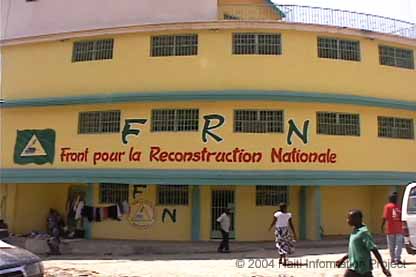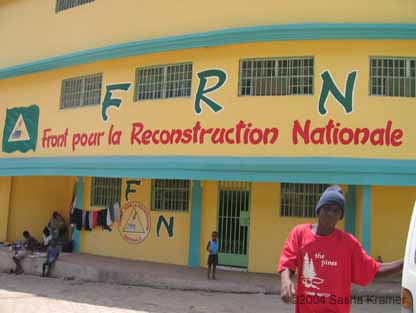|
Resistance and Repression
6 Months After the Coup August 22 2004 |
News HaitiAction.net |
||||
- The Cap Haitien March
- The Caravan for Justice
6 Months After the Coup
by Sasha Kramer & Zoe Moskovitz
Each year on August 14th Haitians celebrate Bwa Kayiman, a vodou ceremony that marks the beginning of the slave revolt that started the Haitian revolution in 1791. On this 200th anniversary of the success of the Haitian Revolution and the establishment of the world's first black republic, the celebrations were particularly charged with emotion, irony and dissent as foreign troops again patrol the streets of Haiti and foreign interests challenge the independence for which Haitian's fought and died.
The northern mountain town of Milot is the birthplace of the revolutionary spirit of Haiti and the target of violence for those who would destroy it. Milot borders the northern city of Cap Haitien and was the site of a violent incursion by members of the former military, disbanded in 1995 under President Aristide. On February 22, 2004, just one month after Haiti's bicentennial celebration, a group of 150-200 heavily armed former soldiers entered Milot and Cap Haitien, killing several hundred people and destroying government offices and private homes of popular Lavalas party supporters. The overthrow of municipal governments in the north and the rebel advance on the capital was used as a pretext by the United States and France to remove President Aristide from office. The US State Department cited concerns for Aristide's safety while the Pentagon and the CIA actively undermined it, providing arms to the former military and launching a propaganda campaign designed to make former military criminals, many of them convicted of heinous crimes, appear to be a legitimate opposition party.
Since February 22 municipal governments throughout Haiti have been overthrown. Thousands of elected officials and Lavalas supporters are in hiding. Since the police commissary in Cap Haitien was looted and burned following the military take over, the former military essentially control the city from their freshly painted headquarters in the center of town in cooperation with the US backed interim government police force and clueless UN troops.
We went to Milot on this important date in Haitian history with a group of international observers and journalists to document human rights abuses and witness the first demonstration in the North calling for the return of President Aristide since the coup on February 29th. We spent two days in Milot and Cap Haitien taking testimony from people whose relatives were killed and/or houses vandalized and burned. Although hundreds of human rights abuses have been documented throughout Haiti since the coup, there has been a clear lack of international presence in the north of Haiti - this was the first time the victims we met shared their stories with an international audience. According to one woman under the current outlaw regime "There is no justice; they say we are bugs, not worthy of justice."
On August 13th our delegation accompanied a group of Lavalas supporters and elected officials who have been in hiding on a Caravan of Justice. It traced the path of the former military, stopping at sites where houses were burned and people killed. The following day over 2000 people marched through the streets of Cap Haitien calling for the return of democracy in Haiti, in a small protest relative to the demonstration of up to 20,000 people that took place in Port au Prince the same day. Organizers claimed that the modest turnout actually reflects a momentous turning point for the democracy movement; they were able to use the relative safety provided by the presence of international observers to test the waters for political dissent in this rebel stronghold where it had been unsafe for citizens to protest or leaders to come out of hiding up to this point.
The protest in Cap Haitien was peaceful, well organized and passionate although the threat of violence was ever present. Police and UN troops patrolled the streets with heavy arms while demonstrators kept to the designated route and were instructed to tuck in their shirts to guarantee no weapons were present. It has been suggested that the police and UN actually share power and control of the city with rebel leaders, but at this protest they kept their criminal allies at bay to appease international observers.
In contrast, the protest in Port au Prince had relatively little UN presence, and one off-duty police officer was killed in what appears to have been a power struggle within criminal/SWAT and civilian divisions of the Haitian police force. More shocking, was an event that took place the following day -- approximately 150 members of the former military marched through the streets of Port au Prince unimpeded by UN or Haitian police and openly flaunting heavy weaponry. It has been suggested that this display and the previous day's killing are demonstrations of power by former military leaders meant to intimidate both Haitian civilians who would protest the coup government and against the coup government itself in anticipation of the September 15th disarmament date.
Although these protests were relatively peaceful, much of the violence that rules the political situation in Haiti takes place at night. In the days following the demonstration, Septembre Luckner, a police officer who appealed for international protection, and his 10 year old brother were found burned to death in the town of Thomazeau. Another Lavalas militant was found in a Delmas neighborhood of the capital hung from a tree with his tongue cut out. The flagrant disregard for human rights and democracy with which the current coup government operates is obvious to those who care to look beyond the story told by most international media sources.
While the celebration of Bwa Kayiman and the concurrent demonstrations in Cap Haitien and Port au Prince celebrated the spirit of Haitian independence despite active political repression, the decision makers at the national palace in Port au Prince have done the equivalent of replacing the Haitian flag with an American flag. Since the coup, the dates of Haitian independence 1804 - 2004, proudly displayed in ten-foot letters on the National Palace for the bicentennial celebrations, have been altered with the first 0 conspicuously absent. It now reads 184 - 2004. The group of 184 is an anti-Lavalas organization masquerading as a civil society group led by prominent business leaders active in the campaign to unseat Aristide. From 2001-2003 the European Commission contributed approximately $890,000 and USAID allocated $3,050,000 to organizations affiliated with this group. It is important to note that all of this funding occurred under an official aid embargo that financially paralyzed the elected government of Haiti. In stark contrast to resistance movement that we witnessed, the defacement of the National Palace disrespects the Haitian people and their proud history serving as a constant reminder of the power wielded by the elites and the foreign interests that fund them.

Former police officer Guy Phillipe has opened this new headquarters for his political party the Front for National Reconstruction in Cap Haitien. Phillipe was accused of drug trafficking in a Drug Enforcement Agency (DEA)report in 2000 and was accused of human rights violations by Human Rights Watch and Amnesty International. Phillipe along with Jodel Chamblain used the Dominican Republic as a staging ground to launch bloody incursions into Haiti assassinating Lavalas officials and their families. They entered into Haiti with a larger force trained in the D.R. on February 12, 2004 on a killing and burning spree aimed at toppling the government of Jean-Bertrand Aristide. As a reward for their role, the US-installed government of Gerard Latortue has embraced them as "freedom fighters" and allowed Phillipe to build his own political party - the Front for National Reconstruction (FRN) - while the violent repression of Lavalas continues. -HIP




The sign was changed on August 9th to read "184-2004."
On August 25th, two days after this photo appeared - right here on www.HaitiAction.net - the sign was changed back to read "1804-2004."
